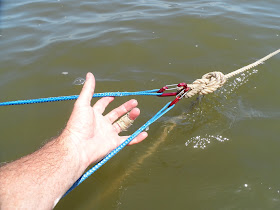A nice feature of the Wilderness Systems Aspire kayaks is a retractable skeg. Deployed, the boat tracks arrow straight, but retracted it turns like a (sluggish) white water boat. However, the skeg is somewhat fragile, prone to breaking when dragged on-deck or across rocks when not retracted, and we do tend to forget.
A
Factory Replacement for $22.00 would have been one option, and I might have done that had the factory gotten back to me right away, but they took over a week, and by that time I was done.
Additionally, I've been playing with flexible repairs using polyurethane sealant reinforced with Sunbrella canvas. I used this method on the mini-dodger, I've used it for household repairs, and I used it here. The advantage is a skeg that will give when striking a rock, like a rubber flipper, which makes a lot of sense to me.
Placing Sunbrella over the crack, after coating with polyurethane sealant. I will add 2 more layers, with sealant between them and over the top.
Locktite PL S30 has proven to make permanent bonds to many plastics, including polyethylene and ABS (what the skeg is made off) so long as the surface is coarse sanded and flame treated. Flame treating is the process of waving a propane torch over the plastic just enough to cause a slight blush, which changes the surface chemistry.
The back corner was broken off. Now there is a nice flexible tip that can't break. It looks a little lump, but the feel and stiffness is like a mud flap.
After that, just laminate as though it was epoxy and fiberglass, alternating layers until the desired thickness is reached. I used 3 layers of cloth; larger pices on the sides and a thicker filler in the center. I trimmed to to size with a razor knife and a grinder. The result is something like a tire side wall, depending on the thickness.
I wish I'd taken before pictures. I dive into projects too fast sometimes.
I've also used this method to repair leaky ponds, cat carriers, and plastic tanks. What are other good applications for a tough, flexible lamination?




